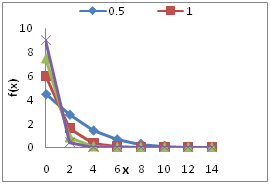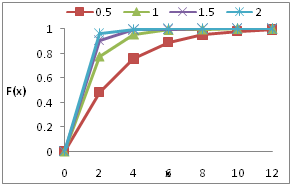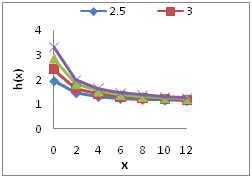
Research Article Volume 4 Issue 7
Garima distribution and its application to model behavioral science data
Rama Shanker
Regret for the inconvenience: we are taking measures to prevent fraudulent form submissions by extractors and page crawlers. Please type the correct Captcha word to see email ID.

Department of Statistics, Eritrea Institute of Technology, Eritrea
Correspondence: Rama Shanker, Department of Statistics, Eritrea Institute of Technology, Asmara, Eritrea
Received: September 30, 2016 | Published: December 9, 2016
Citation: Shanker R. Garima distribution and its application to model behavioral science data. Biom Biostat Int J. 2016;4(7):275-281. DOI: 10.15406/bbij.2016.04.00116
Download PDF
Abstract
In this paper a continuous distribution named “Garima distribution” has been suggested for modeling data from behavioral science. The important properties including its shape, moments, skewness, kurtosis, hazard rate function, mean residual life function, stochastic ordering, mean deviations, order statistics, Bonferroni and Lorenz curves, entropy measure, stress-strength reliability have been discussed. The condition under which Garima distribution is over-dispersed, equi-dispersed, and under-dispersed are presented along with other one parameter continuous distributions. The estimation of its parameter has been discussed using maximum likelihood estimation and method of moments. The application of the proposed distribution has been explained using a numerical example from behavioral science and the fit has been compared with other one parameter continuous distributions.
Keywords: lifetime distribution, moments, hazard rate function, mean residual life function, mean deviations, order statistics, estimation of parameter, goodness of fit
Introduction
The modeling and analyzing lifetime data are crucial in many applied sciences including behavioral science, medicine, engineering, insurance and finance, amongst others. There are a number of continuous distributions for modeling lifetime data such as exponential, Lindley, gamma, lognormal, and Weibull and their generalizations. The exponential, Lindley and the Weibull distributions are more popular than the gamma and the lognormal distributions because the survival functions of the gamma and the lognormal distributions cannot be expressed in closed forms and both require numerical integration. Though each of exponential and Lindley distributions has one parameter, the Lindley distribution has one advantage over the exponential distribution that the exponential distribution has constant hazard rate whereas the Lindley distribution has monotonically decreasing hazard rate.
Recently Shanker1–4 has introduced new lifetime distributions, namely Shanker, Akash, Aradhana, and Sujatha distributions for modeling lifetime data from biomedical sciences, engineering and behavioral sciences and showed its superiority over Lindley5 and exponential distributions. The probability density function (p.d.f.) and the cumulative distribution function (c.d.f.) of Sujatha, Aradhana, Akash, Shanker, Lindley and exponential distributions are presented in Table 1.
Distributions |
Pdf |
Cdf |
Sujatha |
|
|
Aradhana |
|
|
Akash |
|
|
Shanker |
|
|
Lindley |
|
|
Exponential |
|
|
Table 1 pdf and cdf of Sujatha,4 Aradhana,3 Akash,2 Shanker,1 Lindley5 and exponential distributions
A new lifetime distribution
The probability density function (p.d.f.) of a new lifetime distribution can be introduced as
(2.1)
We would call this distribution, “Garima distribution”. This distribution can be easily expressed as a mixture of exponential
and gamma
with mixing proportion
. We have
(2.2)
where
.
The corresponding cumulative distribution function (c.d.f.) of (2.1) is given by
;
(2.3)
The graphs of the p.d.f. and the c.d.f. of Garima distributions for different values of
are shown in Figure 1.


Figure 1 Graphs of the pdf and cdf of Garima distribution for various values of the parameter θ.
Moments and related measures
The
the moment about origin of Garima distributon (2.1) has been obtained as
and so the first four moments about origin as
,
,
,
Using the relationship between central moments and the moments about origin, the central moments of Garima distribution are obtained as
Thus the coefficient of variation
, coefficient of skewness
, coefficient of kurtosis
and index of dispersion
of Garima distribution are obtained as
The condition under which Garima distribution is over-dispersed
, equi-dispersed
and under-dispersed
are presented in Table 2 along with other lifetime distributions.
Lifetime
Distributions |
Over-Dispersion
|
Equi-Dispersion
|
Under-Dispersion
|
Garima |
|
|
|
Sujatha |
|
|
|
Aradhana |
|
|
|
Akash |
|
|
|
Shanker |
|
|
|
Lindley |
|
|
|
Exponential |
|
|
|
Table 2 Over-dispersion, equi-dispersion and under-dispersion of Garima, Sujatha,4 Aradhana,3 Akash,2 Shanker,1 Lindley,5 and exponential distributions for varying values of their parameter θ
Generating functions
The moment generating function
, characteristic function
, and cumulant generating function
of Garima distribution (1.3) are given by
Using the expansion
, we get
Thus the
th cumulant of Garima distribution is given by
= coefficient of
in
This gives
Which the same are as obtained earlier.
Hazard rate function and mean residual life function
Let
be a continuous random variable with pdf
and cdf
. The hazard rate function (also known as the failure rate function) and the mean residual life function of
are respectively defined as
(5.1)
and
(5.2)
The hazard rate function,
and the mean residual life function,
of Garima distribution are given by
(5.3)
and
(5.4)
It can be easily verified that
and
.It is also obvious from the graphs of
and
that
is an increasing or decreasing function of
, and
, where as
is a decreasing function of
, and
. The graph of the hazard rate function and mean residual life function of Garima distribution are shown in Figures 2 & 3.


Figure 2 Graph of hazard rate function of Garima distribution for different values of parameter θ.


Figure 3 Graph of mean residual life function of Garima distribution for different values of parameter θ.
Stochastic orderings
Stochastic ordering of positive continuous random variables is an important tool for judging their comparative behavior. A random variable
is said to be smaller than a random variable
in the
- stochastic order
if
for all
- hazard rate order
if
for all
- mean residual life order
if
for all
- likelihood ratio order
if
decreases in
.
The following results due to Shaked & Shanthikumar [6] are well known for establishing stochastic ordering of distributions
(6.1)
The Garima distribution is ordered with respect to the strongest ‘likelihood ratio’ ordering as shown in the following theorem:
- Theorem: Let
Garima distributon
and
Garima distribution
. If
, then
and hence
,
and
.
- Proof: We have
Now
This gives
Thus for
,
. This means that
and hence
,
and
.
Mean deviations
The amount of scatter in a population is measured to some extent by the totality of deviations usually from mean and median. These are known as the mean deviation about the mean and the mean deviation about the median defined by
and
, respectively, where
and
. The measures
and
can be calculated using the relationships
(7.1)
and
(7.2)
Using p.d.f. (2.1) and expression for the mean of Garima distribution, we get
(7.3)
(7.4)
Using expressions from (7.1), (7.2), (7.3), and (7.4), the mean deviation about mean,
and the mean deviation about median,
of Garima distribution are obtained as
(7.5)
(7.6)
Order statistics
Let
be a random sample of size
from Garima distribution (2.1). Let
denote the corresponding order statistics. The p.d.f. and the c.d.f. of the
th order statistic, say
are given by
and
,
respectively, for
.
Thus, the p.d.f. and the c.d.f of
th order statistics of Garima distribution are given by
and
Bonferroni and lorenz curves
The Bonferroni and Lorenz curves7 and Bonferroni and Gini indices have applications not only in economics to study income and poverty, but also in other fields like reliability, demography, insurance and medicine. The Bonferroni and Lorenz curves are defined as
(9.1)
and
(9.2)
respectively or equivalently
(9.3)
and
(9.4)
respectively, where
and
.
The Bonferroni and Gini indices are thus defined as
(9.5)
and
(9.6)
respectively.
Using p.d.f. (2.1), we get
(9.7)
Now using equation (8.7) in (8.1) and (8.2), we get
(9.8)
and
(9.9)
Now using equations (9.8) and (9.9) in (9.5) and (9.6), the Bonferroni and Gini indices of Garima distribution (2.1) are obtained as
(9.10)
(9.11)
Renyi entropy
Entropy of a random variable
is a measure of variation of uncertainty. A popular entropy measure is Renyi entropy [8]. If
is a continuous random variable having probability density function
, then Renyi entropy is defined as
where
.
Thus, the Renyi entropy for the Garima distribution (2.1) is obtained as
Stress-strength reliability
The stress- strength reliability describes the life of a component which has random strength
that is subjected to a random stress
. When the stress applied to it exceeds the strength, the component fails instantly and the component will function satisfactorily till
. Therefore,
is a measure of component reliability and in statistical literature it is known as stress-strength parameter. It has wide applications in almost all areas of knowledge especially in engineering such as structures, deterioration of rocket motors, static fatigue of ceramic components, aging of concrete pressure vessels etc.
Let
and
be independent strength and stress random variables having Garima distribution (2.1) with parameter
and
respectively. Then the stress-strength reliability
of Garima distribution can be obtained as
.
Estimation of parameter
Maximum likelihood estimates (MLE)
Let
be a random sample from Garima distribution (2.1). The likelihood function,
of (2.1) is given by
The natural log likelihood function is thus obtained as
Now
where
is the sample mean.
The maximum likelihood estimate,
of
is the solution of the equation
and so it can be obtained by solving the following non-linear equation
(12.1.1)
Method of moment estimates (MOME)
Equating the population mean of the Garima distribution to the corresponding sample mean, the method of moment estimate (MOME)
, of
can be obtained as
(12.2.1)
A numerical example
In this section the goodness of fit of the Garima distribution has been discussed with an example from behavioral science. The data is related with behavioral sciences, collected by Balakrishnan N et al. [9]. The scale “General Rating of Affective Symptoms for Preschoolers (GRASP)” measures behavioral and emotional problems of children, which can be classified with depressive condition or not according to this scale. A study conducted by the authors in a city located at the south part of Chile has allowed collecting real data corresponding to the scores of the GRASP scale of children with frequency in parenthesis, which are:
19(6) |
20(15) |
21(14) |
22(9) |
23(12) |
24(10) |
25(6) |
26(9) |
27(8) |
28(5) |
29(6) |
30(4) |
31(3) |
32(4) |
33 |
34 |
35(4) |
36(2) |
37(2) |
39 |
42 |
44 |
|
|
In order to compare distributions,
, AIC (Akaike Information Criterion), AICC (Akaike Information Criterion Corrected), BIC (Bayesian Information Criterion),K-S Statistics ( Kolmogorov-Smirnov Statistics) for above data set have been computed and presented in Table 3. The formulae for computing AIC, AICC, and BIC are as follows:
,
,
The best distribution is the distribution which corresponds to lower values of
, AIC, AICC, and BIC.
It can be easily seen from above table that the Garima distribution is better than Aradhana, Sujatha, Akash, Shanker, Lindley and exponential distributions for modeling behavioral science data and thus Garima distribution should be preferred over Aradhana, Sujatha, Akash, Shanker, Lindley and exponential distributions for modeling behavioral science data.
Model |
ML Estimate |
|
AIC |
AICC |
BIC |
Garima |
0.05317 |
188.32 |
190.32 |
190.35 |
193.23 |
Aradhana |
0.11557 |
989.49 |
991.49 |
991.52 |
994.40 |
Sujatha |
0.11745 |
985.69 |
987.69 |
987.72 |
990.60 |
Akash |
0.11961 |
981.28 |
983.28 |
983.31 |
986.18 |
Shanker |
0.07974 |
1033.10 |
1035.10 |
1035.13 |
1037.99 |
Lindley |
0.07725 |
1041.64 |
1043.64 |
1043.68 |
1046.54 |
Exponential |
0.04006 |
1130.26 |
1132.26 |
1132.29 |
1135.16 |
Table 3 MLE’s,-2ln L, AIC, AICC, and BIC of Garima, Aradhana, Sujatha [4], Akash [2], Shanker [1], Lindley [5] and exponential distributions
Conclusion
A one parameter lifetime distribution named, “Garima distribution” has been proposed and studied. Its mathematical properties including shape, moments, skewness, kurtosis, hazard rate function, mean residual life function, stochastic ordering, mean deviations, order statistics, Bonferroni and Lorenz curves, Renyi entropy and stress-strength reliability have been discussed. The condition under which Garima distribution is over-dispersed, equi-dispersed, and under-dispersed are presented along with the conditions under which Sujatha, Aradhana, Akash, Shanker, Lindley and exponential distributions are over-dispersed, equi-dispersed and under-dispersed. The method of moments and the method of maximum likelihood estimation have also been discussed for estimating its parameter. Finally, a numerical example from behavioral science has been considered for the goodness of fit of Garima distribution and the fit has been compared with Sujatha, Aradhana, Akash, Shanker, Lindley and exponential distributions. The goodness of fit of the Garima distribution shows that it is an important model for modeling behavioral science data.
NOTE: The paper is named in loving memory of my niece Garima Satypriya, daughter of my respected brother Prof. Uma Shanker, Department of Mathematics, K.K College of Engineering & Management, Biharsharif, Nalanda, India.
Acknowledgments
Conflicts of interest
References

©2016 Shanker. This is an open access article distributed under the terms of the,
which
permits unrestricted use, distribution, and build upon your work non-commercially.


